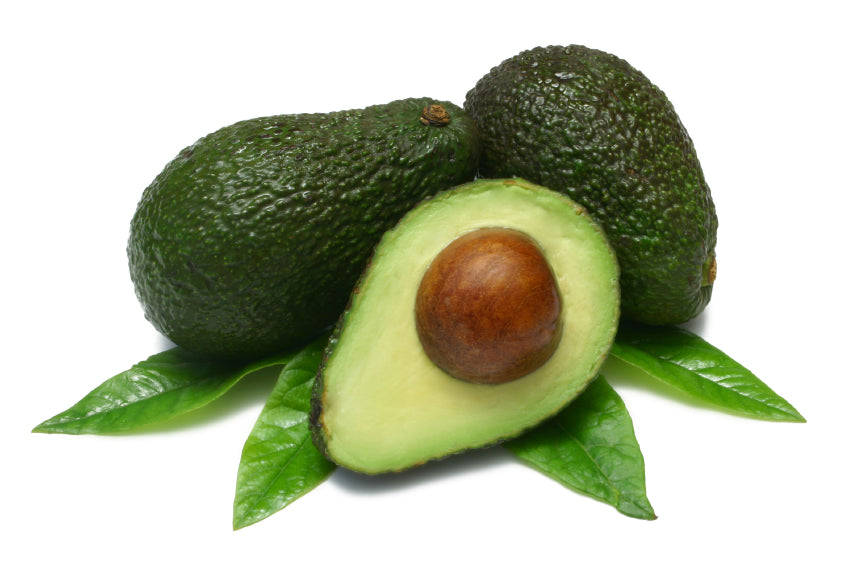The avocado was first grown in Southern Mexico, enjoyed by Native Americans and cultivated by the Aztecs. Seeds of avocados, determined to be 10,000 years old, have been found in caves south of Mexico City. Throughout the sixteenth century, Spanish explorers to South and Central America made reference to these strange pears whose edible part is a paste similar to butter and noted the compatibility of the avocado with cheese.
The avocado, whose botanical name is Persea Americana,is a member of the Lauraceae or laurel family, along with cinnamon and bay leafs. All members of this family have a woody part to them, easily noted in the hard seed at the center of the avocado.
Although we are most familiar with the Hass Avocado, there are at least 80 varieties of avocado. Avocado plants were planted in Florida and California in 1850. Today approximately 90 percent of the U.S. avocado market and 10 percent of the world avocado market is produced in California.
The Seed
The hard pit at the center of the avocado is not widely considered edible, but it is rich in anti-oxidants and potassium. The skin and the seed are usually discarded when oils or the fruit are commercially prepared. In an effort to minimize waste, extracts are made from the polyphenol-rich skin and seeds. These extracts are added to oils and to burger meat to prevent oxidation, extending their shelf life.
Eating avocado seeds is not harmful to humans, except the mechanical difficulty of chewing such a woody seed. There are avocado enthusiasts who advocate blending the seed and adding it to smoothies, oatmeal or other foods. The assumption that the presence of polyphenols in the seed means that they come out simply by blending is misleading.
The anti-oxidants present in the dense material of the avocado skin and seed are obtained via an extraction process that is beyond the capacity of a blender.
Nutrients
The avocado is extremely nutrient dense, and people who eat them are less likely to have common nutritional deficiencies than most Americans. A typical serving size is one half of an avocado, and it provides a rich variety of nutrients.
Each half of an avocado contains 4.6g of fiber, very little sugar (0.2g), and lots of water, making it an ideal snack for diabetics. Along with its rich fatty acid content, the high fiber and water content creates a food that satisfies hunger for longer and improves weight loss.
The avocado is rich in beneficial monounsaturated fatty acids (MUFAs, 71 percent), some polyunsaturated fatty acids (PUFAs, 13 percent) and saturated fats (16 percent). It contains no cholesterol.
The small amount of saturated fat in the avocado actually decreases as it ripens, converting to more oleic acid, the primary MUFA in avocados. Monounsaturated fatty acids are liquid at room temperature, so you can note this process yourself as the fruit becomes more pliable over time.
In addition to fatty acids, avocados contain double the potassium found in bananas, very little sodium, lecithin and high amounts of several other vitamins and minerals including magnesium, vitamins A, C, E and K1, B vitamins folate, B2, B3, B5 and B6, choline, antioxidants such as lutein/zeaxanthin and cryptoxanthin and phytosterols.
It is the only plant food that is high in both vitamin C, a water-soluble anti-oxidant, and vitamin E, a fat-soluble antioxidant.
Beyond the nutrient benefit that the avocado itself brings to the diet, the use of avocados or avocado oil on a salad actually increases absorption of other anti-oxidants, especially carotene. Add an avocado to meals with carrots, salsa and spinach and other carotene rich foods to get the maximum benefit.
Did You Know?
Enhance the phytonutrient content of your avocado snack by eating the dark green layer found along the nutrient-rich peel and seed. Use the nick and peel method suggested by the California Avocado Association:
1) Cut the avocado in half the long way, all the way down to the seed.
2) Cut the avocado in half the long way again, creating 4 long quarters.
3) Rotate the avocado in your hands to separate the quarters.
4) Pull the seed out gently with your fingers.
5) Peel the fruit gently by sliding your thumb under the peel to start, and then pulling the peel back off the fruit.
Subscribe to our Trusted Health Club newsletter for more information about natural living tips, natural health, oral care, skincare, body care and foot care. If you are looking for more health resources check out the Trusted Health Resources list.
Reviewed By:
Founder Ray Spotts has a passion for all things natural and has made a life study of nature as it relates to health and well-being. Ray became a forerunner bringing products to market that are extraordinarily effective and free from potentially harmful chemicals and additives. For this reason Ray formed Trusted Health Products, a company you can trust for clean, effective, and healthy products. Ray is an organic gardener, likes fishing, hiking, and teaching and mentoring people to start new businesses. You can get his book for free, “How To Succeed In Business Based On God’s Word,” at www.rayspotts.com.




